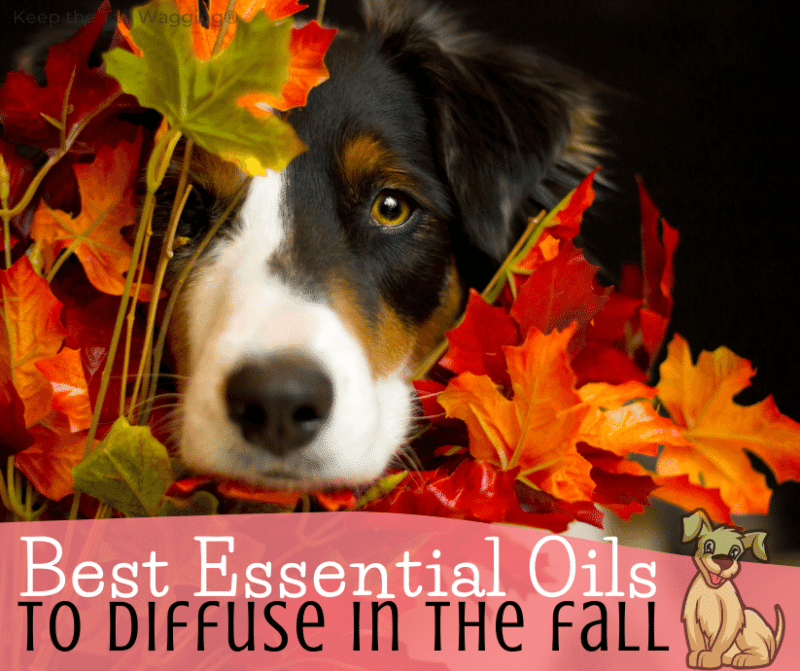Keep the Tail Wagging is supported by pet parents. I occasionally earn a commission (at no additional cost to you) when you click through an affiliate link to one of my favorite products. Thank you for your support. Read More
I'm swapping my capri pants for cozy sweaters in September, October, and November. I'm also getting used to rinsing off paws and drying dogs after a walk in the rain. I love burning Pet Safe candles and diffusing essential oils to rid the house of that wet dog smell while evoking a cozy, warm, and comforting atmosphere. In this article, I'm sharing my favorite ten essential oils to diffuse during the fall season, all of which are safe around dogs.
What are Essential Oils?
Essential oils are highly concentrated, aromatic compounds extracted from various parts of plants, including leaves, flowers, bark, stems, and roots, through processes like steam distillation, cold-press extraction, or solvent extraction. These oils capture the natural scent and essence of the plant and can have a wide range of therapeutic properties and benefits, including calming or uplifting effects and anti-inflammatory benefits.
Essential oils can be used in many ways, including inhalation/diffusing and topical when diluted with a carrier oil. I would not use essential oils internally without the guidance of a qualified veterinarian professional.
It's important to note that essential oils are highly concentrated, and their potency can vary. Some essential oils may be unsafe for use on or around pets. Before purchasing an essential oil, I read about it in The Animal Desk Reference II: Essential Oils for Animals by Dr. Melissa Shelton, founder of the premier essential oil brand AnimalEO. This detailed guide educates pet owners about essential oils, including their safety, efficacy, proper use and dilution, and more.
Essential Oils vs. Candles
Diffusing essential oils and burning candles both have pros and cons. Here are a few reasons why I prefer diffusing essential oils over burning candles:
- Non-Toxic: Many commercially available candles are made from paraffin wax. When burned, paraffin wax can release harmful toxins into the air, including benzene and toluene. Although paraffin wax candles have been deemed safe by the FDA, I prefer not to use them because there are safer alternatives. Diffusing essential oils is a natural and toxin-free way to scent your space.
- Therapeutic Benefits: Essential oils have various therapeutic properties and can positively impact mood, relaxation, focus, and overall well-being. They make the house smell nice and create a calming and relaxing environment for the humans and dogs in the home as the oils are released into the air and inhaled.
- Customizable Scents: With essential oils, you have the flexibility to create a unique scent blends by combining different oils according to your preferences and needs. This allows for a genuinely personalized aromatic experience, which may not be possible with pre-made scented candles.
- Pure Aroma: Essential oils provide a pure and concentrated aroma, containing the natural aromatic compounds extracted from plants. On the other hand, scented candles often contain synthetic fragrances that may not provide the same level of purity or quality.
- Variety and Versatility: Essential oils offer a wide variety of scents, from floral and citrusy to earthy and woody, allowing you to experiment and find your favorite aromas. Additionally, essential oils can be used for a range of purposes beyond just scenting, including relaxation, immune support, and respiratory health.
- Safety Considerations: Candles pose potential fire hazards if left unattended or accidentally knocked over. Diffusers, especially ultrasonic diffusers, are generally safer to use as they do not involve an open flame.
We still have candles in the house because sometimes they also create a relaxing environment, they come in handy during a power outage, and Pet House candles have unique scents that make our home inviting.
Best Scents for Autumn
I diffuse the following essential oils in our home, in open rooms, allowing our dogs to leave if the scene is too strong. Adding 30 drops of a favorite scent is tempting, but it's essential to consider the room size – the larger the space, the more drops I may add to the diffuser.
Cinnamon: The rich and spicy aroma of cinnamon essential oil is perfect for fall. It can create a cozy atmosphere and evoke feelings of warmth and comfort.
Clove: Clove essential oil has a warm and spicy scent that is often associated with fall. It can help create a cozy and inviting atmosphere.
Sweet Orange: Sweet orange essential oil has a bright and uplifting scent that can add a touch of freshness to the fall season. It blends well with other fall scents like cinnamon and clove.
Cedarwood: Cedarwood essential oil has a warm and woody aroma that can remind you of the outdoors during fall. It can create a grounding and calming atmosphere.
Nutmeg: With its warm and slightly sweet fragrance, nutmeg essential oil is often used during fall. Its cozy scent can help create a comforting atmosphere.
Ginger: Ginger essential oil has a warm and spicy aroma that can bring a sense of warmth to the fall season. It can also help promote feelings of energy and vitality.
Patchouli: Patchouli essential oil has a deep, earthy, and musky scent that can add a sense of grounding and relaxation to the fall ambiance.
Choosing the Right Diffuser for Essential Oils
When choosing a diffuser for essential oils, it's tempting to focus on price, but there are a few factors to consider before clicking “Buy Now.”
Types of Diffusers
Various types of diffusers are available, each with its features and benefits.
- Ultrasonic Diffusers (recommended): These diffusers use water and ultrasonic vibrations to disperse a fine mist of essential oils into the air. They often come with additional features like LED lights and timers. Ultrasonic diffusers are popular for their ease of use and ability to humidify the air.
- Nebulizing Diffusers: Nebulizing diffusers use pressurized air to break essential oils into tiny particles, dispersing them into the air without water or heat. They provide an intense concentration of essential oils and are ideal for therapeutic use but not necessary when using essential oils to provide a scent in a home.
- Heat Diffusers: Heat diffusers use heat, often generated by a candle or electric heat source, to gently warm the essential oils and release their aroma. They are simple and often the most affordable option, but they may alter the chemical composition of the oils. I also worry about the safety of the heat source because sometimes I leave diffusers running when I leave the house for a quick errand or overnight.
- Evaporative Diffusers: These diffusers use a fan or a reed diffuser to evaporate the essential oils into the air. They are often portable and easy to use, but the aroma may not be as concentrated or long-lasting. While these are easy and affordable, I find that I use more essential oils to get the same results experienced with an ultrasonic diffuser.
Room Size and Coverage
Consider the size of the room where you plan to use the diffuser. Some diffusers are designed for small spaces, while others are appropriate for larger areas. When reviewing the specs of a diffuser, look for the coverage area in the manufacturer's notes to ensure the diffuser can effectively disperse oils in your desired space.
Runtime and Timer
Look for a diffuser with a suitable runtime for your needs. Some diffusers can run continuously for several hours, while others have intermittent settings or built-in timers that allow you to control the diffusion duration. Dogs have a stronger sense of smell than humans; therefore, I prefer diffusers that turn off and on periodically. This prevents our home (or a room) from becoming overwhelmed by a scent.
Noise Level
Another reason I recommend ultrasonic diffusers is the noise level; they're generally quiet, while other diffusers produce a louder humming sound.
Design and Aesthetics
I like diffusers that blend into the room and often choose ones with a wood design that allows them to disappear into a corner of the room. Diffusers come in various designs, materials, and colors; no matter your style, you'll find one that fits your tastes.
Ease of Cleaning
Before buying, check the maintenance requirements of the diffuser, including cleaning instructions and whether or not it has removable parts for easy cleaning. Regular cleaning is vital to prevent buildup of essential oils and ensure optimal performance.
What's Your Budget?
Consider your budget and choose a diffuser that fits within your price range. Depending on their features and functionalities, diffusers can range from affordable to more expensive. The diffusers I own cost less than $20 each. I've had several for over three years and never had an issue with them.
If you're still not sure, read the customer reviews. Look for reviews that detail the pros and cons of the diffuser; this will give you a good idea of how the product will work for you.
Ultimately, the best diffuser for you depends on your personal preferences, desired features, and budget. Consider the factors mentioned above to make an informed decision and choose a diffuser that meets your specific needs.
Final Thoughts on Essential Oils
When using essential oils, it's important to follow proper safety guidelines. I do not use these oils on my dogs or myself. If you're looking for essential oils that can be applied to your dog, please check out AnimalEO. Dr. Melissa Shelton has an entire line of therapeutic essential oils that are safe for use with dogs.
And, when using essential oils, pay attention to your dog. If they leave the room each time you start the diffuser, this may be a sign that the scent is too strong or you're using too much oil.
















